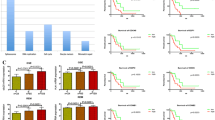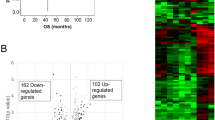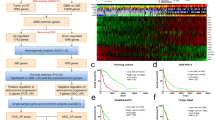Abstract
Objective
To identify progression-related genes that lead to astrocytoma progression from a low to a high grade by analyzing the gene expression profi1es from different tumor grades, and all-trans retinoic acid-treated astrocytoma cell lines.
Methods
In this study, all-trans retinoic acid (ATRA) was used to induce differentiation of SHG-44 cells. Then, by using a cDNA microarray, we compared gene expression profiling in different grades of astrocytoma cell lines (CHG-5, WHO Grade II and SHG-44, WHO Grade IV) and in ATRA- induced differentiation in SHG-44 cells. A panel of overlapped genes that might be related to tumor progression was identified, and the cell line individual variation was avoided as well.
Results
In the 31 overlapped genes, the stable over-expression of MDM2 and UGB as well as the repression of SOD2, G3BP, and CSTB in parental SHG-44 cells was observed and their possible roles in tumor progression were discussed. Moreover, validation of some differentially expressed genes was confirmed by Northern blots.
Conclusion
The overlapped genes reported in this study might relate to progression of astrocytoma. Further study of progression-related genes may be helpful to explore the genetic pathways that are involved in astrocytoma progress from a low to a high grade.
Similar content being viewed by others
References
Kleihues P, Louis DN, Scheithauer BW, et al. The WHO classification of tumors of the nervous system. J Neuropathol Exp Neurol 2002; 61: 215–225.
Huang HT, Colella S, Kurrer M, et al. Gene expression profiling of low-grade diffuse astrocytomas by cDNA arrays. Cancer Res 2000; 60: 6868–6874.
Markert JM, Fuller CM, Gillespie GY, et al. Differential gene expression profiling in human brain tumors. Physiol Genomics 2001; 5: 21–33.
Sallinen SL, Sallinen PK, Haapasalo HK, et al. Identification of differentially expressed genes in human gliomas by DNA microarray and tissue chip techniques. Cancer Res 2000; 60: 6617–6622.
Grummer MA, Salih ZN, Zachman RD. Effect of retinoic acid and ethanol on retinoic acid receptor beta and glial fibrillary acidic protein mRNA expression in human astrocytoma cells. Neurosci Lett 2000; 294: 73–76.
Kerley JS, Olsen SL, Freemantle SJ, et al. Transcriptional activation of the nuclear receptor corepressor RIP140 by retinoic acid: a potential negative-feedback regulatory mechanism. Biochem Biophys Res Commun 2001; 285: 969–975.
Kim EJ, Kang YH, Schaffer BS, et al. Inhibition of Caco-2 cell proliferation by all-trans retinoic acid: role of insulin-like growth factor binding protein-6. J Cell Physiol 2002; 190: 92–100.
Correa RG, Sasahara RM, Bengtson MH, et al. Human semaphorin 6B [(HSA) SEMA6B], a novel human class 6 semaphorin gene: alternative splicing and all-trans-retinoic acid-dependent down-regulation in glioblastoma cell lines. Genomics 2001; 73: 343–348.
Du ZW. Establishment of human malignant glioma cell line (SHG-44) and observation on its characteristics. Zhonghua Zhong Liu Za Zhi 1984; 6: 241–243 (Chinese).
Bian X, Chen Z, Guo D, et al. Expression of angiogenic factors and cell cycle regulation factors in human glioblastoma cell line SHG-44. Zhonghua Bing Li Xue Za Zhi 1999; 28: 178–181 (Chinese).
Chen J, Zhang Y, Wu Y. Expression of the O6-methyl-guanine-DNA methyltransferase gene in eight human tumor cell lines. Chin Med Sci J 1994; 9: 143–146.
Chen ZQ, Bian XW, Xin R, et al. Establishment of human glioma cell line CHG-5 and its biological features. Acta Academiae Medininae Militaris Tertiae 1999; 21: 880–883.
Bouterfa H, Picht T, Kess D, et al. Retinoids inhibit human glioma cell proliferation and migration in primary cell cultures but not in established cell lines. Neurosurgery 2000; 46: 419–430.
Chattopadhyay N, Butters RR, Brown EM. Agonists of the retinoic acid- and retinoid X-receptors inhibit hepatocyte growth factor secretion and expression in U87 human astrocytoma cells. Mol Brain Res 2001; 87: 100–108.
Kohleisen B, Hutzler P, Shumay E, et al. HIV-1 Nef co-localizes with the astrocyte-specific cytoskeleton protein GFAP in persistently nef-expressing human astrocytes. J Neurovirol 2001; 7: 52–55.
Hunter S, Young A, Olson J, et al. Differential expression between pilocytic and anaplastic astrocytomas: identification of apolipoprotein D as a marker for low-grade, non-infiltrating primary CNS neoplasms. J Neuropathol Exp Neurol 2002; 61: 275–281.
Balint EE, Vousden KH. Activation and activities of the p53 tumor suppressor protein. Br J Cancer 2001; 85: 1813–1823.
Kleihues P, Ohgaki H. Primary and secondary glioblastomas: from concept to clinical diagnosis. Neurooncol 1999; 1: 44–51.
Momand J, Wu HH, Dasgupta G. MDM2—master regulator of the p53 tumor suppressor protein. Gene 2000; 242: 15–29.
Tews DS. Cell death and oxidative stress in gliomas. Neuropathol Appl Neurobiol 1999; 25: 272–284.
Drane P, Bravard A, Bouvard V, et al. Reciprocal down-regulation of p53 and SOD2 gene expression-implication I p53 mediated apoptosis. Oncogene 2001; 20: 430–439.
Oberley LW. Anticancer therapy by overexpression of superoxide dismutase. Antioxid Redox Signal 2001; 3: 461–472.
Zhou R, Deng J, Chen P. Biological action in vitro and anti-tumor effect in vivo of lung adenocarcinoma cells A549 infected with adenovirus-mediated MnSOD. Zhongguo Xian Dai Yi Xue Za Zhi 2004; 14: 58–60 (Chinese).
Shiraishi T, Mori M, Tanaka S, et al. Identification of cystatin B in human esophageal carcinoma, using differential displays in which the gene expression is related to lymph-node metastasis. Int J Cancer 1998; 79: 175–178.
Kos J, Krasovec M, Cimerman N, et al. Cysteine proteinase inhibitors stefin A, stefin B, and cystatin C in sera from patients with colorectal cancer: relation to prognosis. Clin Cancer Res 2000; 6: 505–511.
Peri A, Bonaccorsi L, Muratori M, et al. Uteroglobin reverts the transformed phenotype in the endometrial adenocarcinoma cell line HEC-1A by disrupting the metabolic pathways generating platelet-activating factor. Int J Cancer 2000; 88: 525–534.
Fleming TP, Watson MA. Mammaglobin, a breast-specific gene, and its utility as a marker for breast cancer. Ann N Y Acad Sci 2000; 923: 78–89.
Grunewald K, Haun M, Urbanek M, et al. Mammaglobin gene expression: a superior marker of breast cancer cells in peripheral blood in comparison to epidermal-growth-factor receptor and cytokeratin-19. Lab Invest 2000; 80: 1071–1077.
Gallouzi IE, Parker F, Chebli K, et al. A novel phosphorylation-dependent RNase activity of GAP-SH3 binding protein: a potential link between signal transduction and RNA stability. Mol Cell Biol 1998; 18: 3956–3965.
Liu Y, Zheng J, Fang W, et al. Identification of metastasis associated gene G3BP by differential display in human cancer cell sublines with different metastatic potentials G3BP as highly expressed in non-metastatic. Chin Med J 2001; 114: 35–38.
Author information
Authors and Affiliations
Corresponding author
Additional information
This work was supported partly by a grant from the Sichuan Provincial Bureau of Health, China (No.050209).
About this article
Cite this article
Zeng, Y., Yang, Z., You, C. et al. Identification of tumor progression-related genes in astrocytoma cell lines. Chin. J. Clin. Oncol. 5, 391–399 (2008). https://doi.org/10.1007/s11805-008-0391-x
Received:
Accepted:
Published:
Issue Date:
DOI: https://doi.org/10.1007/s11805-008-0391-x




